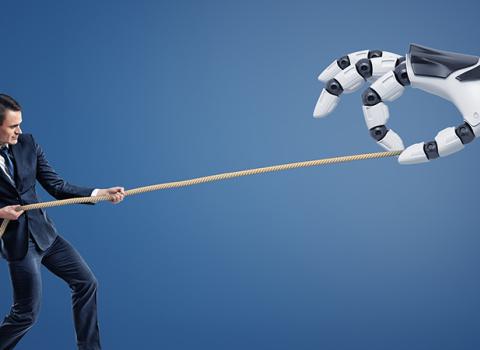An automated grasshopper; a gyroscope that allows a robot cricket to balance itself, before bouncing again and again; a small glider that flies and clings to walls like a flying squirrel. When Mirko Kovac is showing off his ultra-light robots in the Laboratory of Intelligent Systems (LIS) at the Swiss Federal Institute of Technology (EPFL), it is almost like standing in front of one of the graceful wire mobiles fashioned by the artist Alexander Calder. That’s because these tiny automatons, so different from the bulky and complex androids of Star Wars, take their inspiration from nature itself.
Looking to nature to inspire new designs is one of the most promising avenues in robotics today, with the EPFL researchers leading the way. Along with the LIS, three other EPFL laboratories - LASA – Learning Algorithms and Systems Laboratory, managed by Aude Billard; DISAL – Distributed Intelligent Systems and Algorithms Laboratory, led by Alchiero Martinoli; and BioRob – the Biorobotics Laboratory, run by Auke Ijspeert, are taking a lead from biology when designing new robots. Now, all four are coming together in a new dedicated robotics centre, and within the next two years will have their own building on the Lausanne campus.
Four-year funding
The move is funded by a four-year grant of CHF 13.3 million (€10 million) for a National Centre of Competence in Research (NCCR), the lead programme of the Swiss National Science Foundation. This was matched with CHF 6.9 million from EPFL itself. The centre, NCCR Robotics – Intelligent Robots for Improving the Quality of Life, also brings in partners including ETH Zurich, the University of Zurich and the artificial intelligence institute ISDIA, and will be led by Lausanne. It begins its mission with 17 principal investigators, and including PhD students, postdocs and new professors, the total number of researchers will reach 80 to 100 by the time the centre is fully operational.
The NCCR’s mission is broader than just bio-robotics. It encompasses an emerging field of engineering which aims to develop human-oriented robotic technology. Examples include, “care robots” to help elderly people to continue independent living in their own homes; “neuroprosthetic” and “exoprosthetic” robots to aid people with disabilities; “educational robots” to support training, and “environmental robots” to do cleaning and monitoring.
Adapt and cooperate
To achieve this, the NCCR will be drawing on research, education and technology transfer. What makes the centre stand out is the bio-inspired robotics approach developed by the Lausanne researchers. Instead of trying to programme a complex set of functions – walking, vision, anticipation and so on – in a single human-looking android, biomimetic scientists like Kovac are interested in developing cheap and basic robots that can adapt as well as cooperate. “You may build a ten-kilogram robot to carry out a specific task. But when it breaks down, it is all over. The alternative is to create a thousand micro robots weighing only ten grams. Even if half of them fail, the task will go on,” Kovac explains.
Sitting behind Kovac’s technological developments is breakthrough research by Dario Floreano, the director of the LIS. Floreano, too, has drawn inspiration from nature to program his robots, beginning with stripped down, basic building blocks of software. Over time, these different bits of software mix and are selected for, in an almost Darwinian way. At a certain point during this evolution, a kind of intelligence emerges. Learning through a process of trial and error, the robot manages to pick the combination of software blocks most suited to its particular task – a bit like genes combining to regulate specific biological functions.
Floreano’s “evolutionary robotics” is currently focusing on the synthesis of analogue electrical circuits, of neural controllers that learn, the reverse engineering of genetic and metabolic networks, and biomedical signal processing.
When robots work together, the artificial intelligence becomes yet more evident. Floreano and his team looked to living organisms whose efficiency also based on combined intelligence – insects. This led to a collaboration with Laurent Keller, a renowned entomologist and ant specialist from Lausanne University (UNIL).
”What we notice with insects is that elements of their intelligence are distributed around their body,” explains Jean-Christophe Zufferey, Floreano’s senior assistant. This observation prompted the researchers to begin to study the biomechanical properties of insects and apply these properties to their robots. To take one example, the Airburr project capitalises on the principles behind an insect’s exoskeleton to create a collision-resistant flying robot.
Useful insects
A passionate pilot and Swiss aerobatic champion, Zufferey has created a miniature plane that imitates a fly. The robot, which weighs less than 10 grams, replicates the main sensors that allow a fly to avoid obstacles. “A camera mimics the fly’s compound eye, inertial sensors its sense of direction, and a micro-anemometer its hairs, which can sense the airflow,” Zufferey says. The result is a micro-plane that can fly autonomously.
Late in 2009 EPFL’s bio-inspired robotics passed an important milestone when Zufferey created a spin-off company, senseFly to market the Swinglet, a mini-drone that can monitor crop fields and sensitive industrial sites. He also deploys a swarm of mini-drones to generate a temporary WiFi network – which could be vital to rescuers at a disaster site when all the traditional communication infrastructures are down.
Kovac is also focusing on emergencies and the surveillance of sensitive sites, using a swarm of robot-crickets that can jump 60 centimetres in the air to locate their whereabouts, and get their balance back before bouncing again. The swarm could be used to look for victims at an earthquake site, or to give warnings about the spread of a forest fire.
With this ability to adapt to the natural environment, and to see, sense and communicate, swarms of bio-inspired robots are now poised to become a practical proposition – which is more than can be said of the complex and energy-demanding C3PO-like androids of Star Wars.




 A unique international forum for public research organisations and companies to connect their external engagement with strategic interests around their R&D system.
A unique international forum for public research organisations and companies to connect their external engagement with strategic interests around their R&D system.